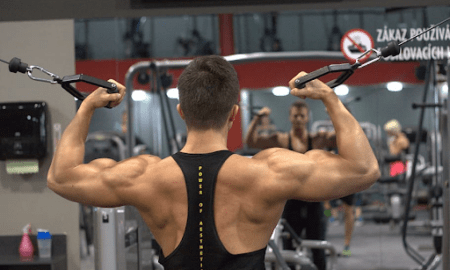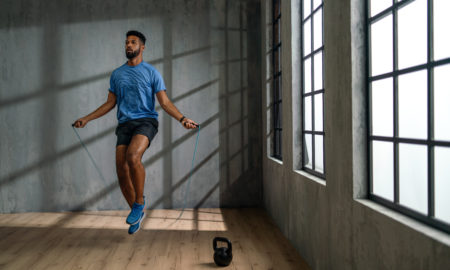Q: I have trouble feeling my chest working on bench presses. I’m in phase 1 of Jonathan’s X-traordinary Size Surge Workout program, so my sets for chest are limited. Is it okay to do more bench press work sets, or should I add an isolation exercise like pec deck flyes?
A: First, be sure you’re using the concentrated warmup sequence for big, multijoint exercises that I’ve outlined here before. For those who missed it:
Warmup set 1: 10 reps, three seconds up and three seconds down (light 60-second set)
Warmup set 2: Add weight and do eight reps at a normal pace—one to two seconds up and about three seconds down. Also, don’t lock out—keep tension on the target muscle for extra blood flow.
If you’re already doing this and you still don’t feel your pecs on your bench press work sets, it’s time for an additional bloodbath technique, postactivation.
After your two warmup sets of bench presses, do one set of medium-intensity cable crossovers, cable flyes or pec deck flyes. Any isolated chest exercise that keeps continuous tension on your pecs will work.
Take a fairly light poundage and squeeze out 12 controlled reps, keeping tension on your pecs throughout the set. It should not be an all-out set to failure—the last few reps should cause a burn in your pecs but should not be difficult.
After you’re done, you’ll feel a rush of blood to your pecs. Now they’re ready. Rest about one minute, then do your first work set of bench presses. You should feel your pecs elongating and contracting on every rep.
Some trainees get much stronger with the extra target-muscle blood volume. Studies show that it can enhance power output by as much as 20 percent!
You can use the postactivation warmup technique on any bodypart. Simply do a slow higher-rep continuous-tension set of an isolation move after your warmup sets and before your first work set. It triggers more blood flow to grow.
Q: What’s the difference between bent-over dumbbell rows and one-arm dumbbell rows [in Positions-of-Flexion mass training]? You list them as separate exercises in the POF program [in the e-book X-traordinary X-Rep Workout].
A: For bent-over dumbbell rows you row with both arms at the same time. We suggest using chest support, such as an incline bench or a special bench made for the exercise, but that’s not mandatory.
Bent-over dumbbell rows will give you a killer midback contraction at the top because your hands can move out as you pull the dumbbells up. With the two-arm move you’re better able to squeeze your shoulder blades together to contract your traps.
For one-arm dumbbell rows you work one arm at a time, your free arm supported on the dumbbell rack or a bench. The move is classified as a stretch-position exercise for midback, but it’s not that great for contraction. Why? The squeeze at the top is compromised because of a sideways torso shift—your upper body rolls to the nonrowing side, which impairs the midback contraction at the top. The stretch at the bottom is very pronounced, however—better than the two-arm version.
By working one arm at a time, you can lower the dumbbell down and over past the torso’s center line. That inward arm angle at the bottom of the stroke forces max trap elongation.
So, if you want a total POF midback hit, follow this sequence:
1) Achieve midrange midback work, which you get when you train lats.
2) Do one-arm dumbbell rows for stretch.
3) Do the two-arm version for contraction (with chest support, if possible).
If you have time for only one midback exercise, choose the two-arm overgrip version, as it provides some stretch at the bottom when the dumbbells move together and total contraction when you drive them up and out for a top-end squeeze.
Q: I agree with your progressive-overload theory of gradually making workouts more intense. You suggest adding a few forced reps every two weeks in the first phase of the Size Surge program, but I train alone and can’t do forced reps. How can I make my workouts progressively more intense?
A: Here’s the forced-rep progression for the three-days-a-week workouts in phase 1 of the Size Surge program:
Weeks 1 and 2: Go to positive failure only.
Weeks 3 and 4: Add forced reps to set 2 on pyramids.
Week 5: Do one forced rep on set 1 and two on set 2 on the pyramids.
Week 6: Downshift, stopping all sets two reps short of failure; then move to Phase 2.
That progressively builds the intensity so you stimulate new gains every week. And, of course, you should push to add weight as you get stronger as well.
Your problem, however, is that you can’t do forced reps because you train alone, so static holds and rest/pause will give you the Size Surge progressions you’re after. Here’s a good plan:
Weeks 1 and 2: Go to positive failure only.
Weeks 3 and 4: Go to failure on each work set and add a static hold at the sticking point on all sets (on your last rep drive the weight as high as you can, and hold for three to five seconds).
Week 5: Use the static hold on the last rep of the first set; on the second set go to failure, rest for 20 seconds, then do as many reps as you can with the same weight, ending with a static hold.
Week 6: Downshift—stop all sets two reps short of failure for full muscle supercompensation to prepare for the full-range muscle-training onslaught of phase 2.
A static hold will be too dangerous on exercises like squats and deadlifts. Simply do as many reps as you can, and keep fighting to add more weight to the bar for progressive overload.
Note that in the e-book Size Surge Jonathan mentions that he frequently used static contractions when he had to train alone during the original 10-week experiment.
Q: I’ve written to you before about the progress I’ve made using your workouts—I’ve gained 17 1/2 pounds of muscle in the past three months, and my arm measurement is up almost an entire inch! My question: I used your Winter-Workout Mass Plan [1) two weeks on the Basic X-traordinary X-Rep Workout; 2) two weeks on the Basic Power-Density Mass Workout; 3) a downshift week, stopping all work sets before failure; 4) four weeks on the Heavy/Light 10×10 Mass Workout]. I’m finishing up the workouts, but I’m not sure what to do next. I saw the new e-book, Size Surge, but wasn’t sure if it was all that different from those I have. I want to keep growing! I’m so excited, and I want to be ready with a plan.
A: If you followed the Winter-Workout Mass Plan, you ended with the Heavy/Light Ultimate 10×10 Mass Workout (pages 28-33 of the e-book 10×10). For the uninitiated, that’s hitting a bodypart with heavy, straight POF, then at the next workout for that bodypart doing only one big exercise for 10 sets of 10—that’s it. Light-day bodypart workouts take only about 10 minutes, but the pump is insane!
Notice that you alternate power and density at every workout for each muscle group, which is a great way to get the key 2A fast-twitch fibers to grow to the extreme. Now you should make another change to continue to gain.
You’re primed for a mini-Size Surge. Do each phase for only three to four weeks. You said you wanted something different, and this is unique in that it’s an anabolic primer routine first, followed by pure Positons of Flexion. The first phase is big, basic power-oriented workouts done three days a week on a unique split:
Monday: Legs, chest, back, delts
Wednesday: Deadlifts, arms, abs, calves
Friday: Legs, chest, back, delts
That works so incredibly well because of metabolic priming for anabolic hormone release, which Jonathan explains in the new e-book. Plus, you get a recovery day between workouts—very important!
Then you move to the second phase, straight-up pure POF to reshock muscle growth with stretch overload and full-range mass routines at every workout (there are two unique phase 2 program options; I suggest the second, a three-way split, so your workouts are shorter than Jonathan’s original every-other-day two-way split).
From there you could go back through the Winter-Workout Mass Plan that gave you such great gains, or start The Ultimate Fat-to-Muscle Workout if you need to burn off bodyfat for spring and summer.
Your motivation is high, so you really can’t go wrong with any of the programs you’ve got. The key to keeping gains coming is periodic change and intensity, and from the sound of it, you’re tearing it up in the gym!
Editor’s note: Steve Holman is the author of many bodybuilding best-sellers and the creator of Positions-of-Flexion muscle training. For information on the POF videos and Size Surge programs, see the ad sections beginning on pages 274 and 264, respectively. Also visit www.X-Rep.com for information on X-Rep and 3D POF methods and e-books. IM
Note: Jonathan Lawson’s e-book X-traordinary Size Surge Workout is available at www.SizeSurgeWorkout.com. The Winter-Workout Mass Plan e-books are available at www.X-traordinaryWorkouts.com. The Ultimate Fat-to-Muscle Workout is available at the X Shop at www.X-Rep.com.




















You must be logged in to post a comment Login